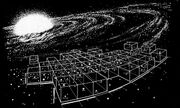No edit summary |
No edit summary |
||
| (9 intermediate revisions by 4 users not shown) | |||
| Line 12: | Line 12: | ||
| Affiliation = |
| Affiliation = |
||
}} |
}} |
||
| − | '''Lactra VII''' was the [[seventh planets|seventh]] [[planet]] of the Lactra |
+ | '''Lactra VII''' was the [[inhabited planets|inhabited]] [[seventh planets|seventh]] [[planet]] of the Lactra [[star system|system]]. This [[Class M|M class]] planet with [[Earth]]-normal [[atmosphere]] and [[gravity]] was the [[homeworld]] for the [[Lactran]]s, a highly advanced non-[[humanoid]] [[telepathy|telepathic]] [[species]]. The planet was located several [[light year]]s away from [[Canopus III]]. ({{TAS|The Eye of the Beholder}}) |
| − | [[File: |
+ | [[File:The Explored Galaxy.jpg|thumb|left|The location of Lactra VII in "The Explored Galaxy" star chart]] |
| + | In [[2293]], the location of Lactra VII in the [[Milky Way Galaxy]] was labeled in a [[star chart]] that was in [[Captain]] [[James T. Kirk]]'s [[quarters]] aboard the {{USS|Enterprise|NCC-1701-A|-A}}. ({{film|6}}, ''[[okudagram]]'') |
||
| + | ==History== |
||
| − | The Federation had no previous information on the |
+ | The Federation had no previous information on the planet prior to the six-week survey mission conducted by the {{USS|Ariel}} in [[2269]]. |
| − | [[Sensor]] scans later conducted by the {{USS|Enterprise|NCC-1701}}, supported by several surface contacts, revealed a variety of lifeforms on the planet from such planets as |
+ | [[Sensor]] scans later conducted by the {{USS|Enterprise|NCC-1701}}, supported by several surface contacts, revealed a variety of lifeforms on the planet from such planets as Canopus III and [[Maravel]]. Portions of Lactra VII were heavily [[terraforming|terraformed]], however, not done so in the traditional pattern, as several of the biomes seemed to be patterned at random. |
| ⚫ | [[Landing party]] observations made by the crew of the ''Enterprise'' noted that the planet featured several different [[ecology|ecologies]] co-existing significantly close to each other. One such example included a [[desert]] and a [[rainforest]] separated by a [[river]]. The [[water]] discovered on Lactra VII was clear and palatable, but was, according to [[Spock]], "too pure." |
||
| − | Portions of Lactra VII were heavily [[terraforming|terraformed]], however, not done so in the traditional pattern, as several of the biomes seemed to be patterned at random. |
||
| − | |||
| ⚫ | |||
| − | |||
| − | The [[water]] discovered on Lactra VII was clear and palatable, but was, according to [[Spock]], "too pure." |
||
Sensors later revealed a [[Lactran city|large concentration]] of [[lifeform]]s 98.5 [[kilometer]]s northeast of the desert. Lactra VII was particularly well noted for having an [[Lactra VII zoo|immense zoo]]. ({{TAS|The Eye of the Beholder}}) |
Sensors later revealed a [[Lactran city|large concentration]] of [[lifeform]]s 98.5 [[kilometer]]s northeast of the desert. Lactra VII was particularly well noted for having an [[Lactra VII zoo|immense zoo]]. ({{TAS|The Eye of the Beholder}}) |
||
| − | |||
| − | {{bginfo|''The Explored Galaxy'': This chart was also seen in several ''[[Star Trek: The Next Generation]]'' and ''[[Star Trek: Deep Space Nine]]'' episodes set in the [[24th century]], from the year [[2364]] to [[2370]]. These were: {{TNG|Conspiracy|The Measure Of A Man|The Emissary|The Mind's Eye|The Game}} and {{DS9|In the Hands of the Prophets|Cardassians}}.}} |
||
[[de:Lactra VII]] |
[[de:Lactra VII]] |
||
Revision as of 08:15, 21 July 2014
Lactra VII was the inhabited seventh planet of the Lactra system. This M class planet with Earth-normal atmosphere and gravity was the homeworld for the Lactrans, a highly advanced non-humanoid telepathic species. The planet was located several light years away from Canopus III. (TAS: "The Eye of the Beholder")

The location of Lactra VII in "The Explored Galaxy" star chart
In 2293, the location of Lactra VII in the Milky Way Galaxy was labeled in a star chart that was in Captain James T. Kirk's quarters aboard the USS Enterprise-A. (Star Trek VI: The Undiscovered Country, okudagram)
History
The Federation had no previous information on the planet prior to the six-week survey mission conducted by the USS Ariel in 2269.
Sensor scans later conducted by the USS Enterprise, supported by several surface contacts, revealed a variety of lifeforms on the planet from such planets as Canopus III and Maravel. Portions of Lactra VII were heavily terraformed, however, not done so in the traditional pattern, as several of the biomes seemed to be patterned at random.
Landing party observations made by the crew of the Enterprise noted that the planet featured several different ecologies co-existing significantly close to each other. One such example included a desert and a rainforest separated by a river. The water discovered on Lactra VII was clear and palatable, but was, according to Spock, "too pure."
Sensors later revealed a large concentration of lifeforms 98.5 kilometers northeast of the desert. Lactra VII was particularly well noted for having an immense zoo. (TAS: "The Eye of the Beholder")
